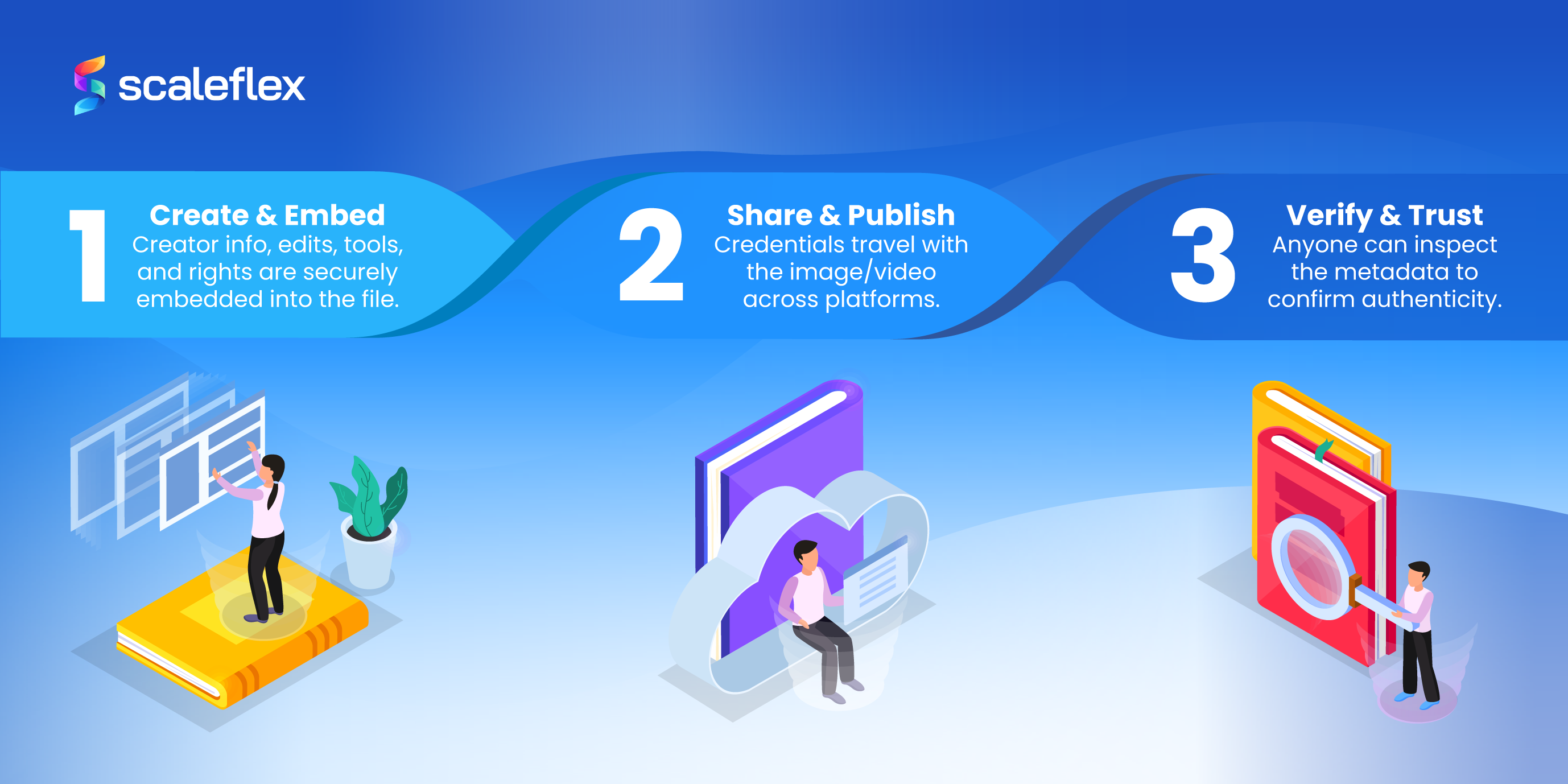Rebuilding Trust On The Web With Content Credentials
A new chapter of the internet is commencing - one where trust is the currency of value. This new age will be shaped by generative AI, synthetic media and viral misinformation, and so the ability to verify the origin and evolution of any given content will become essential.
As users, we’re constantly inundated with visual input: polished marketing visuals, AI-generated product images, short-form videos… Can we always tell what’s real, what’s edited, who made what? Increasingly, we’re finding that we can’t, and reflecting on how transparent disclosure of content sources can be linked to an ethical use of AI - and that’s where content credentials come in.
You can think of content credentials as a digital label of transparency. They’re metadata, attached to an image or video, and they tell its story: who created it, what changes it has gone through, what tools were used along the way. It’s a critical form of traceability that adds a layer of context and integrity to the web.
Content credentials are currently a technical upgrade, but they will soon bring forth a cultural and strategic shift, one that search engines and platforms are starting to enforce. Today we’ll explore how the credentials work, why they matter and what they can mean for brands and content teams managing digital assets at scale. Let’s dive in.
What are content credentials, really?
Content credentials are a form of digital provenance at their core, excerpts of metadata that are directly embedded into images, videos and any other digital file. They offer a transparent trail, showing where the content came from, how and by whom it was made, and what happened to it along the way.
Contrary to typical metadata (file size, resolution, etc) content credentials capture meaningful and humanly readable information. They can include, but are not limited to:
- The name of the original creator, be it a person or organization
- The timestamp and location of creation
- Its editing history, including the tools that were used (Photoshop, AI generators, etc)
- Any rights or usage declarations
- A cryptographic signature that ensures the data hasn’t been tampered with
The credentials are a part of an emerging technical standard that’s being promoted by the Content Authenticity Initiative (known as CAI), led by Adobe and supported by organizations such as the BBC, Microsoft, The New York Times and others. In addition to the C2PA (Coalition for Content Provenance and Authenticity) they’re building open, interoperable ways to embed provenance into visual media.
The purpose isn’t to restrict creation, nor to impose new rules, but rather to make the creative process more transparent. Thanks to the credentials, viewers can easily inspect the story behind a file, and make their own judgments about its credibility.
For the teams that are producing, editing and managing digital content, it represents a major step forward. Traceability is enabled without friction, ensuring that even as media is becoming more complex, its truth remains accessible to everyone.

Why search engines and platforms are getting involved
Content credentials are quickly becoming a critical part of how the web organizes and ranks its information. Major search engines are actively exploring ways of integrating content provenance into search results, with a particular focus on images and news content. The goal is to highlight trustworthy and verifiable media.
The rise of AI-generated visuals and deepfakes have put platforms under increasing pressure to combat misinformation. To embed transparent, tamper-proof metadata can help users understand what they’re seeing, where it came from and how it was made, effectively adding a layer of context that algorithms can then evaluate when it comes to surfacing search results or recommending content.
For instance, Google has taken to labeling AI-generated images with metadata that points to their origin. Future updates will probably go even further, in the sense that they’ll reward content that includes standardized credentials with improved visibility.
Beyond SEO rankings, this signals an upcoming shift for digital content strategies. Credibility is about to become a major ranking factor, and early adopters will stay ahead of policy shifts and shape user expectations around digital transparency.
How content credentials work in practice
How do content credentials actually get embedded, and what exactly do they contain?
Content credentials are technically stored as cryptographically signed metadata inside of the file itself, which means that the information will travel with the content wherever it goes: across platforms, tools or websites. It can’t be modified without breaking its signature. It makes the data tamper-evident as well as verifiable.
In order to verify this data, anyone can use a supported viewer and the information will appear as a transparent overlay, with no interruption to the image, all the while offering insight into its journey. A bit like content “nutrition labels”: they’re optional to read, but powerful for those who would like to understand what they’re consuming.
For businesses that manage high volumes of content, or heavily edited or AI-enhanced visuals, this provides a way to document the creative workflow without any additional overhead. It will keep assets traceable and empower viewers to trust what they see.
Adding transparency to content on the web - content credentials explained.
Implications for DAM, workflows and digital assets
Content credentials are gaining traction, and Digital Asset Management systems and visual workflows are set to evolve in order to support them technically as well as strategically. Being able to manage, preserve and surface provenance data will become a defining feature of modern content operations.
What it’ll look like in practice:
- Automatic embedding: as assets are created and exported, your DAM should be able to automatically embed the content credentials into each file.
- Version control transparency: assets will go through edits and iterations, and the DAM has to retain not just the different versions, but also the metadata trail explaining how each of the versions came to be.
- Credential visibility in portals: if sharing visuals via portals, showing embedded content credentials will offer an added layer of trust, so that stakeholders know what they’re looking at and who created it.
- Future proof compliance: search engines and content platforms are starting to require credentials, and so supporting them natively will be essential in order to maintain discoverability and compliance.
Content credentials act as a chain of custody for digital visuals, and your DAM is the link that can hold it all together. Teams that work across geographies, departments or creative agencies can make use of this transparency to maintain consistency, attribution and brand integrity.
Content credentials can be the shift from DAM being a storage tool to becoming part of a trust infrastructure, which ensures that what you create, publish and deliver is high-quality as well as verifiable.
Conclusion
Content moves fast and authenticity is under constant scrutiny. Those are just facts, and content credentials are a powerful solution that provide transparency without friction. They’re not aimed at policing creativity, but rather providing content credibility. They help creators, brands and platforms offer context and build trust.
Everyone benefits when the story behind an image is accessible, and as platforms and search engines start prioritizing verifiable media, adopting credentials early is a strategic advantage.
Teams that manage digital assets at scale should take it as an invitation to rethink workflows, upgrade tools and build transparency into the creative process. They may seem like a small technical feature but make no mistake, they represent a big shift in how we communicate online.





